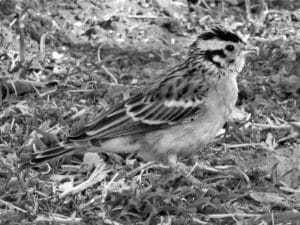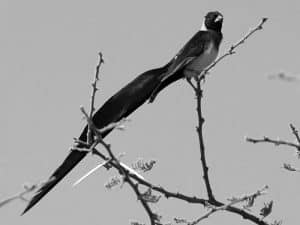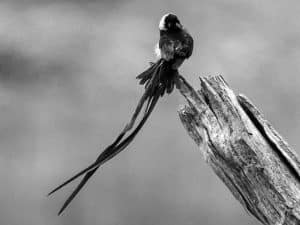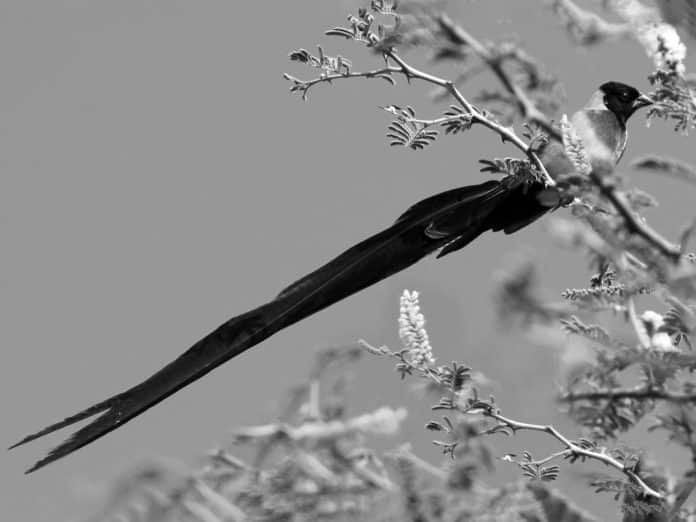Introduction to the Eastern Paradise-Whydah bird
The Eastern Paradise-Whydah, a captivating avian species, is a true gem in the rich tapestry of Tanzania’s diverse wildlife. This remarkable bird, with its striking plumage and unique behavioral traits, has long captivated the hearts and minds of birdwatchers, nature enthusiasts, and conservationists alike. As you delve into the world of the Eastern Paradise-Whydah in Tanzania, you’ll uncover a fascinating tale of adaptation, survival, and the intricate balance of Tanzania’s avian ecosystem.
Habitat and behavior of the Eastern Paradise-Whydah

The Eastern Paradise-Whydah thrives in the lush, verdant landscapes of Tanzania, making its home in a variety of habitats, from open savannas and grasslands to the fringes of woodlands and forests. This adaptable species has learned to coexist with human settlements, often spotted in agricultural areas and even urban gardens, where it takes advantage of the abundant food sources and nesting opportunities.
One of the most captivating aspects of the Eastern Paradise-Whydah is its intricate courtship display. During the breeding season, the male birds undergo a remarkable transformation, growing elongated tail feathers that can reach up to three times the length of their body. These magnificent plumes are used to attract potential mates, as the males engage in elaborate aerial displays, fluttering and diving to showcase their impressive appearance. The females, in turn, are drawn to the males with the most striking and well-maintained tail feathers, a testament to their fitness and desirability as mates.
Unique features and physical characteristics of the Eastern Paradise-Whydah
The Eastern Paradise-Whydah is a true visual delight, with a plumage that seems to capture the essence of the Tanzanian landscape. The male birds, during the breeding season, sport a striking black and white color scheme, with a glossy black head, neck, and upper body, contrasted by brilliant white underparts and wing bars. Their most distinctive feature, however, is the elongated tail feathers, which can grow to an astonishing length, creating a mesmerizing and graceful appearance in flight.
The females, on the other hand, possess a more subdued plumage, with a predominantly brown and buff coloration, which helps them blend seamlessly into their surroundings and avoid detection from predators. This subtle camouflage is an essential adaptation, as the females are responsible for the arduous task of nest-building and incubating the eggs, a process that requires them to remain inconspicuous.
Conservation status and efforts to protect the Eastern Paradise-Whydah
Despite its captivating beauty, the Eastern Paradise-Whydah faces a number of threats to its survival. Habitat loss, due to factors such as deforestation, agricultural expansion, and urban development, has led to a decline in the species’ population. Additionally, the illegal wildlife trade, which targets the Eastern Paradise-Whydah for its prized plumage, has further exacerbated the challenges faced by this remarkable bird.
In response to these threats, conservation organizations and government agencies in Tanzania have implemented a range of initiatives to protect the Eastern Paradise-Whydah. These efforts include the establishment of protected areas, the enforcement of strict regulations on the wildlife trade, and the promotion of sustainable land-use practices that prioritize the preservation of the bird’s natural habitats. Additionally, educational campaigns and community outreach programs have been instrumental in raising awareness about the importance of the Eastern Paradise-Whydah and the need for its conservation.
The importance of the Eastern Paradise-Whydah in Tanzania’s avian ecosystem

The Eastern Paradise-Whydah plays a crucial role in the delicate balance of Tanzania’s avian ecosystem. As a pollinator and seed disperser, the bird contributes to the regeneration and maintenance of the region’s plant communities, helping to ensure the continued health and diversity of the local flora. Additionally, the Eastern Paradise-Whydah serves as a valuable food source for a variety of predators, including raptors and small carnivores, thus supporting the overall food web and the interconnectedness of the ecosystem.
Moreover, the presence of the Eastern Paradise-Whydah is a testament to the richness and resilience of Tanzania’s natural heritage. As a flagship species, the bird has the power to inspire and captivate both local and international audiences, fostering a deeper appreciation for the country’s remarkable biodiversity and the importance of its conservation.
Birdwatching and photography opportunities for the Eastern Paradise-Whydah
For birdwatchers and nature photographers, the Eastern Paradise-Whydah presents a truly exhilarating and rewarding experience. During the breeding season, when the males display their magnificent plumage, the opportunities for stunning and memorable captures are abundant. Skilled photographers can position themselves strategically to capture the birds in mid-flight, showcasing the graceful movements and the striking contrast of their black and white feathers against the vibrant Tanzanian landscape.
Birdwatchers, on the other hand, can embark on guided tours and excursions to the best-known habitats of the Eastern Paradise-Whydah, where they can observe the birds in their natural environment, witness their intricate courtship rituals, and gain a deeper understanding of their ecological significance. These experiences not only provide a chance to appreciate the beauty of the species but also contribute to the ongoing efforts to raise awareness and promote the conservation of this remarkable avian jewel.
Best locations in Tanzania to spot the Eastern Paradise-Whydah
Tanzania, with its diverse and well-preserved natural landscapes, offers numerous opportunities to catch a glimpse of the captivating Eastern Paradise-Whydah. Some of the best locations to spot this species include:
- Serengeti National Park: The vast grasslands and savannas of the Serengeti provide an ideal habitat for the Eastern Paradise-Whydah, and visitors are often rewarded with sightings of these birds during their game drives.
- Tarangire National Park: The acacia-dotted landscapes of Tarangire National Park are home to thriving populations of the Eastern Paradise-Whydah, making it a prime destination for birdwatchers and nature enthusiasts.
- Ngorongoro Conservation Area: The diverse habitats within the Ngorongoro Conservation Area, from the lush forests to the open grasslands, offer excellent opportunities to observe the Eastern Paradise-Whydah in its natural environment.
- Lake Manyara National Park: The wetlands and riparian areas of Lake Manyara National Park provide a unique setting for spotting the Eastern Paradise-Whydah, as the bird often forages and nests near the lake’s shores.
- Mikumi National Park: This park, situated in the heart of Tanzania, boasts a rich avian diversity, including the captivating Eastern Paradise-Whydah, which can be observed in the park’s varied habitats.
By exploring these remarkable destinations, you can immerse yourself in the world of the Eastern Paradise-Whydah and witness the beauty and resilience of this iconic Tanzanian species firsthand.
Interesting facts and folklore surrounding the Eastern Paradise-Whydah

The Eastern Paradise-Whydah has long captured the imagination of the Tanzanian people, with numerous legends and folklore surrounding this remarkable bird. In some local traditions, the elongated tail feathers of the male birds are believed to represent the flowing robes of a noble or a spiritual leader, imbuing the Eastern Paradise-Whydah with a sense of mysticism and reverence.
Additionally, the bird’s ability to adapt and thrive in a variety of habitats has earned it a reputation as a symbol of resilience and adaptability. Some communities view the Eastern Paradise-Whydah as a harbinger of good fortune, believing that the presence of the bird in their lands signifies the abundance and prosperity of the land.
These cultural associations and folklore traditions not only reflect the deep connection between the Tanzanian people and their natural heritage but also highlight the importance of preserving and celebrating the Eastern Paradise-Whydah as a vital part of the country’s cultural identity.
The role of tourism in promoting awareness and conservation of the Eastern Paradise-Whydah
Tourism plays a critical role in the conservation and protection of the Eastern Paradise-Whydah in Tanzania. As visitors from around the world flock to the country to experience its rich biodiversity, the demand for birdwatching and wildlife-focused activities has steadily increased. This, in turn, has provided a valuable source of funding and support for conservation efforts, as well as a platform to raise awareness about the importance of protecting the Eastern Paradise-Whydah and its fragile habitat.
By offering guided tours, educational programs, and immersive experiences centered around the Eastern Paradise-Whydah, the tourism industry in Tanzania has the power to inspire and engage both local and international audiences. These initiatives not only foster a deeper appreciation for the bird’s beauty and ecological significance but also encourage sustainable practices and responsible tourism that prioritize the preservation of the species and its natural environment.
Discover the captivating world of the Eastern Paradise-Whydah and plan your Tanzania birdwatching adventure today. Contact our team of experts to curate a tailored itinerary that will allow you to immerse yourself in the wonder of this remarkable avian species and contribute to its ongoing conservation.
Conclusion: Celebrating the beauty and significance of the Eastern Paradise-Whydah in Tanzania
The Eastern Paradise-Whydah is a true testament to the richness and diversity of Tanzania’s natural heritage. This captivating bird, with its striking plumage and unique behavioral traits, has the power to captivate and inspire all who are fortunate enough to witness it in its natural habitat. Through the dedicated efforts of conservation organizations, government agencies, and the tourism industry, the Eastern Paradise-Whydah continues to be celebrated and protected, ensuring that its beauty and ecological significance will be cherished for generations to come.
As you explore the lush landscapes of Tanzania, keep your eyes peeled for the mesmerizing sight of the Eastern Paradise-Whydah, and let its graceful presence fill you with a sense of wonder and appreciation for the natural wonders that this remarkable country has to offer.

































